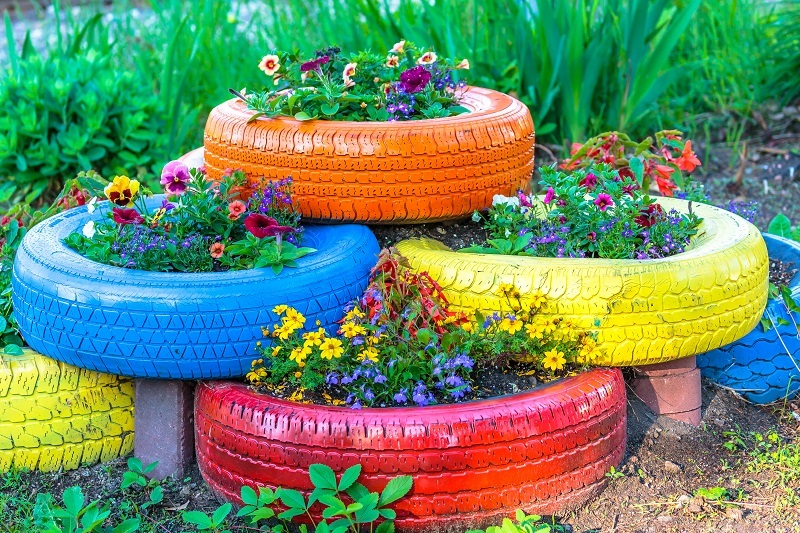The Definitive Handbook for Orchid Lovers
Posted on 13/08/2025
The Definitive Handbook for Orchid Lovers
Are you passionate about orchids, or perhaps just beginning your journey with these magnificent blooms? Welcome to the Definitive Handbook for Orchid Lovers - your ultimate, in-depth guide to growing, caring for, and enjoying the world's most enchanting flowers. Whether you're a dedicated collector, an aspiring hobbyist, or simply captivated by the allure of orchids, this comprehensive article covers every aspect you need for success.

Table of Contents
- Introduction to Orchid Plants
- The Incredible Diversity: Types and Species
- Growing Orchids at Home
- Essential Orchid Care Tips
- Common Problems and Solutions
- Propagation and Repotting Guide
- Displaying Orchids: Decoration and Aesthetics
- Top Orchid Varieties for Beginners
- Advanced Orchid Cultivation
- Further Resources for Orchid Lovers
Introduction to Orchid Plants
Orchids belong to the Orchidaceae family, one of the largest and most diverse plant groups on Earth. With over 25,000 naturally occurring species and more than 100,000 hybrids and cultivars, orchids hail from nearly every continent and ecosystem--from humid jungles to arid mountains.
For centuries, orchids have mesmerized enthusiasts with their striking beauty, unique shapes, and sometimes mysterious growth habits. Today, they continue to be one of the most popular plant choices for indoor gardeners, collectors, and floral designers alike.
If you're keen to start your journey with orchids or want to enhance your collection, this handbook for orchid enthusiasts offers everything you need to succeed.
The Incredible Diversity: Types and Species
Understanding Orchid Variations
From Phalaenopsis (Moth Orchid) to the dramatic Cattleya and the exotic Paphiopedilum (Slipper Orchid), the spectrum of orchid types is vast. Here's a closer look at the main types:
- Epiphytic Orchids: These grow on trees, absorbing moisture and nutrients from the air. Common examples: Phalaenopsis, Dendrobium, Cattleya.
- Terrestrial Orchids: Rooted in the ground, often found in forests or grasslands. Examples: Paphiopedilum, Bletilla.
- Lithophytic Orchids: These grow on rocks--using moss and organic debris for sustenance. Examples: Laelia.
Popular Species Among Orchid Enthusiasts
The main orchid varieties adored by lovers worldwide include:
- Phalaenopsis - The beginner's favorite, known for its enduring blooms and graceful appearance.
- Cattleya - Prized for its huge, colorful flowers and sweet fragrance.
- Dendrobium - A highly diverse group with both miniature and large-flowered options.
- Oncidium - "Dancing Lady" orchids with distinctive, ruffled petals.
- Vanda - Renowned for their vivid colors and large, fragrant flowers.
- Paphiopedilum - Known for their unique, slipper-shaped blooms.
With such variety, every orchid aficionado can find a species to match their preference and environment.
Growing Orchids at Home
Orchid Care Essentials for Beginners
Contrary to popular belief, many orchid plants are not particularly fussy. The key to successful orchid cultivation is mimicking their natural environment. Here's how you can create ideal conditions:
- Light: Most require bright, indirect light. Direct sun may scorch leaves, while insufficient light hinders flowering.
- Temperature: Orchids prefer daytime temperatures between 20-30?C (68-86?F) and cooler nights.
- Humidity: Ideal relative humidity is 40%-70%. Misting or using humidifiers helps, especially indoors.
- Watering: Overwatering is the #1 mistake. Water thoroughly when roots are nearly dry--generally every 7-10 days for most species.
- Potting Media: Use a well-draining orchid mix (bark, sphagnum moss, coconut chips).
- Air Circulation: Good airflow prevents disease; use fans if growing many orchids indoors.
Tip: Observe your orchid's leaves--soft, floppy leaves mean too much water, leathery or wrinkled leaves often signal too little.
Essential Orchid Care Tips
Watering Techniques
One of the most critical aspects of orchid care is proper watering. Overwatering leads to root rot, while under-watering stunts growth. Here's how to win at watering:
- Water in the morning to give leaves and roots time to dry before nightfall.
- Use lukewarm, filtered water, avoiding water with high chlorine or minerals.
- Allow water to drain completely; never let pots sit in standing water.
- Monitor root color: Healthy erect roots are silvery-green; mushy or black roots indicate issues.
Fertilizing Orchids
Orchids need feeding, but less than you might think:
- Use a balanced, water-soluble fertilizer (20-20-20), diluted to half-strength, every 2-4 weeks during active growth.
- Never fertilize dry roots--water first, then fertilize.
- Flush pots with plain water monthly to prevent fertilizer salt buildup.
Pruning and Cleaning
- Trim dead spikes with sterile scissors to encourage re-blooming.
- Clean leaves periodically with a damp cloth to remove dust and pests.
Common Problems and Solutions
Pest Control for Orchid Plants
- Mealybugs: Remove with alcohol-dipped cotton swabs; use insecticidal soap for infestations.
- Spider Mites: Mist plants and increase humidity; use miticides if needed.
- Scale: Scrape off with softened toothbrush, treat with neem oil.
Disease Prevention
- Avoid overcrowding and boost air circulation.
- Fungal Rot: Cut away infected tissue and use fungicides as needed.
- Always use sterilized tools when pruning or dividing plants.

Leaf and Root Troubles
- Yellow Leaves: Too much sun or fertilization.
- Wrinkled Leaves: Under-watering or root damage.
- Root Rot: Remove affected roots, repot promptly.
Propagation and Repotting Guide
Methods of Orchid Propagation
For the dedicated orchid hobbyist, propagation is both an exciting and challenging step. Main methods include:
- Division: Ideal for sympodial types (e.g., Cattleya, Dendrobium); separate pseudobulbs come spring repotting time.
- Keiki Growth: Some orchids (Phalaenopsis, Dendrobium) sprout baby plants (keikis) along stems. Once roots form, gently remove and pot them up.
- Seed Germination: Not for the faint-hearted-orchid seeds require sterile, laboratory-like conditions and can take years to mature.
When and How to Repot Orchids
- Repot every 1-3 years, or when potting mix decomposes.
- Choose a slightly larger, well-drained pot.
- Trim old roots, use fresh orchid mix, and water lightly until growth resumes.
Tip: Always repot after the blooming phase, not during, to reduce plant stress.
Displaying Orchids: Decoration and Aesthetics
Orchid displays can transform any living space into a lush showcase. Here are popular ways to make orchids the centerpiece of your home or office:
- Place orchids in decorative porcelain pots or transparent containers to spotlight their unique roots.
- Create orchid arrangements with mixed species for variety in color and shape.
- Mount small epiphytic orchids on driftwood or cork for an exotic, naturalistic look.
- Use tiered plant stands to display collections and maximize light exposure.
- Highlight blooming orchids in entryways or living rooms--anywhere you want to draw attention.
Remember to ensure adequate light and humidity, even in decorative locations, to keep your orchids healthy and vibrant.
Top Orchid Varieties for Beginners
If you're new to orchid growing, start with these easy-care favorites:
- Phalaenopsis (Moth Orchid) - Long-lasting blooms, tolerant of average home conditions.
- Dendrobium - Hardier hybrids thrive in a variety of indoor environments.
- Cymbidium - Thrives outdoors in mild climates; tolerant and highly floriferous.
- Oncidium (Dancing Lady) - Bright and cheerful flowers, adaptable to indoor light.
- Paphopedilum (Slipper Orchid) - Easy to grow on windowsills, unique compact flowers.
These varieties are a must-have for any aspiring orchid aficionado looking for beauty with minimal fuss.
Advanced Orchid Cultivation
For experienced orchid lovers and collectors, pushing your skills further can yield extraordinary results. Explore these advanced topics:
- Creating microclimates: Use orchidariums or terrariums for rare, humidity-loving species.
- Hybridization: Cross-pollinate compatible orchids to create your very own hybrids.
- Advanced lighting: Supplement natural light with grow lamps to extend flowering seasons.
- Temperature cycling: Mimic cooler night temperatures to initiate blooms in difficult varieties.
- Collecting and cataloguing: Join local orchid societies and participate in shows to exchange knowledge and rare cultivars.
Challenging yourself to master new orchid care techniques unlocks rarer species, longer bloom times, and cultivates boundless enjoyment.
Further Resources for Orchid Lovers
- Books: "Orchid Fever" by Eric Hansen, "The Orchid Whisperer" by Bruce Rogers.
- Websites: American Orchid Society, Royal Horticultural Society Orchids
- Clubs & Societies: Join a local orchid club for support and opportunities to exchange plants.
- Forums & Social Media: Engage with thousands of fellow orchid growers online for daily inspiration.

Final Thoughts: The Joy of Orchids
Whether on a sunny windowsill or a specially constructed greenhouse, the magic of growing orchids lies in their mesmerizing diversity and adaptability. With the right care, these plants reward their keepers with months of breathtaking blooms and years of fascination. Embrace the adventure--let this Definitive Handbook for Orchid Lovers guide your growth from novice to expert, and watch your orchid garden flourish.
Ready to expand your collection? Share your orchid experiences in the comments and help inspire a new generation of orchid lovers!
Latest Posts
Maintain Freshness: Effective Care for Cut Flowers
What Blossom Speaks to Your Heart
Understanding the allure of red roses on Valentine's Day







